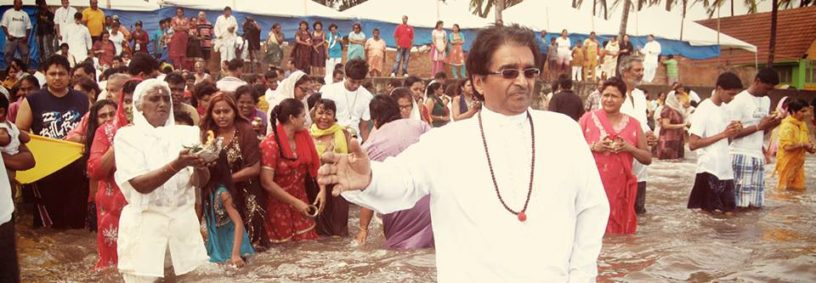Festivals such as Kaartik Nahaan, the Visarjan ceremonies of Shri Ganesh, Hanumanji and other deities are naimittik (occasional) observances that offer opportunities for devotees to immerse themselves in the ocean, symbolising efforts to become one with the Divine. This immersion in the waterways is more than a mere ritualistic dip. It serves as a reminder of the constant need to immerse our lives in spirituality instead of materialism, to make a conscientious effort to transform our lives, to merge in and realise our deeper nature of pure consciousness. It symbolises our inner victory over negative qualities and materialism. It infuses the purifying flow of spiritual abundance and enlightened vision with its attendant positive qualities of serenity, faith, endurance, tranquillity of mind, control of the senses and renunciation of selfish actions and desires. In a state of purified devotion, one realises the divinity within us.
To cultivate this supreme love towards God, we are guided in the Shrimad Bhagavatam by the discourse of Prahlad to his father, the asura king, on navdhaa bhakti or the nine ways of connecting with God. Lord Raama’s explanation to the devotee, Shabri, in the Raamaayan, is similarly espoused in the following practices that are suggested for all in this age:
Satsang: Keeping the company of holy ones
Sravanam: Listening to the glories of the Lord
Guru-Seva: Performing selfless service to the Guru
Kirtanam: Singing the praises of the Lord’s virtues
Mantra-Jaap: Chanting His name with steadfast faith
Archanam: Practising self-control, good character, detachment and dharma
Samadrishti: Practising equanimity of mind and perceiving the world as God himself
Santosh: Attaining a state of contentment and desirelessness
Bharosa: Having full faith in the Divine
On a metaphysical level, the Yajurveda states, “Yatha pinde tatha brahmande, yatha brahmande tatha pinde”: “As the microcosm, so is the macrocosm; as the macrocosm, so too the microcosm.” The three sacred rivers that flow through India, the Ganga, Yamuna and Saraswati, also flow metaphysically within the subtle human body. The Ida Naadi, Pingala Naadi and Sushumna Naadi are three major Naadis, or channels of bio-energy, that are sources of sustenance. They are symbolic of the three rivers and signify devotion, knowledge and disinterested action. As the three rivers merge in Triveni at Prayag, so too, in the human body, these Naadis merge at Ajnaa Chakra in the forehead. Here, the harmonised, rhythmic flow of devotion, accelerated by wisdom and disinterested action merge into a unifying flow of blessedness. Intensely pursuing the path of devotion in accordance with scriptural injunctions is akin to diving into the purifying depths of these sacred rivers, and is conducive to the attainment of oneness with the Divine.
Today, spiritual pollution and degeneration are on the rise in Kal Yug, the final age of the universal cycle. As with the external rivers and oceans, our inner consciousness has been polluted over time by the devolution in religious practices. The objective of these practices has rapidly shifted from attaining oneness with the Divine to attaining material interests. At times, qualities of lust, anger, hatred, egoism and greed contaminate religious actions so much so that our inner nature becomes polluted. Such actions are mere dikhaavat (exhibition) and termed bahya bhakti (external show of devotion). To purify this inner stream of devotion, one needs to prevail over bahya practices and reach the stage of ekaant bhakti, where the focus is on the Supreme Objective.
As we continue on our journey towards self-realisation, it is incumbent upon all to make consistent efforts to immerse daily in the essence of pure devotion. It is the easiest, surest and safest way to reach this destination. May our journey of life be filled with the continuous purification of our internal rivers. May the rivers and oceans flow calmly through and around our land of Trinidad and Tobago, creating peace and blessedness for all. May we all become one with the ocean of pure consciousness and experience the truth of the maxim: “Aham Brahm Asmi”: “I am One with Divinity.”
By Paramacharya of Swaha, Pundit Hardeo Persad
Extract from an article published in the National Council for Indian Culture’s magazine (2014)



